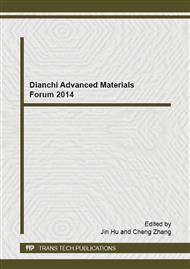p.15
p.20
p.25
p.30
p.35
p.40
p.44
p.48
p.52
Sol-Gel Synthesis of Na2Ta4O11 Nanocrystals Showing High Efficient Photocatalytic Performance
Abstract:
Semiconductors showing high efficient photocatalytic activity have attracted great interest, because they provide a potential solution to many environmental pollution problems that humankind is currently facing. This work reports on the sol-gel synthesis of Na2Ta4O11 nanocrystals and its photocatalytic performance toward Red G. The samples were carefully characterized by X-ray diffraction, transmission electron microscopy, UV-vis diffuse reflectance spectroscopy, and the Barrett–Emmett–Teller technique. By modulating the synthetic condition, the sol-gel reaction yielded pure Na2Ta4O11 nanocrystals with diameter of ~32 nm from the peak broadening of (006) plane using Scherrer formula. It is found that the as-prepared Na2Ta4O11 nanocrystals showed a band gap energy of 3.63 eV, which is much smaller than that of Na2Ta4O11 prepared by flux approach. The relative narrowed band gap energy of Na2Ta4O11 nanocrystals may predict superior photocatalytic activity. By careful photocatalytic test, it is found that Na2Ta4O11 nanocrystals showed excellent photocatalytic activity toward Red G. The photocatalytic degradation efficiency was estimated to be 94.0% within a time intervals of 40 minutes. Controlled experiment by adding active species scavengers gave evidence that the degradation of Red G is dominated by the oxidation reaction of the generated O2-∙ active species taking place on the surface of the photocatalyst.
Info:
Periodical:
Pages:
35-39
Citation:
Online since:
November 2014
Authors:
Keywords:
Price:
Сopyright:
© 2014 Trans Tech Publications Ltd. All Rights Reserved
Share:
Citation:


